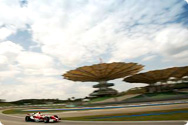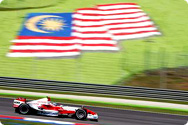|
|
Hot Stuff:Dealing With the Heat of Sepang
17.03.2008
Think of Malaysia and you might think of beautiful beaches or the hustle and bustle of city centre Kuala Lumpur, but for anyone in Formula 1, the Malaysian Grand Prix means heat and humidity.
The modern Sepang circuit has state–of–the–art facilities but no track yet has offered air conditioned garages so the mechanics sweat their way through a tough weekend, and it is equally hard going behind the wheel, with a Formula 1 car built for performance rather than comfort.
Not only is the air temperature extremely high at almost 40°C, so is the humidity at up to 90% and to really put the driver to the test physically, he is strapped into a cockpit just centimetres from the extreme heat of the engine and exhausts, at the same time straining every sinew to get the maximum performance from his car.

This combination makes the Malaysian Grand Prix the most gruelling on the Formula 1 calendar, and a driver can expect to lose around four litres of fluid during the course of the 56–lap race – but Panasonic Toyota Racing drivers Jarno Trulli and Timo Glock are ready for the physical test that awaits them in Sepang.
Jarno has taken part in every one of the nine Malaysian Grands Prix so far, meaning he knows exactly what to expect. He says: “Malaysia is an extremely difficult race and a big challenge for any driver – but also technically for the car because it’s quite a tough track in very hard conditions. It’s torrid over there: almost 40 degrees ambient and 80 or 90% humidity, so it’s the toughest Grand Prix physically and mechanically for everyone.”
But the sure knowledge of an exhausting, arduous race does not dim Jarno- enthusiasm for a Grand Prix which holds a special place in Panasonic Toyota Racing history. The Italian scored the team’s first Formula 1 podium at Sepang with second place in 2005 and he adds: “I’ve always enjoyed good results and good races over there so I’m looking forward to going to Malaysia because our car always has been pretty good.”

For team–mate Timo, the Malaysian Grand Prix will be a new experience as the reigning GP2 champion has only previously completed Formula 1 practice sessions at Sepang, in 2004. However, he dedicated himself to a comprehensive fitness programme before even stepping into the TF108 so he is well prepared for – and warned about – the challenge ahead.
“It is, I think, the hardest race of the season,” he says. “Jarno told me already it sometimes can be quite painful at the end, especially in the last 10–15 laps, but we trained hard enough over the winter so we should be ready. The hard thing is that it is only the second race of the season so you don’t have any opportunity to get used to racing in hot conditions before going to Malaysia.”
Before the race, drivers consume several litres of specially–formulated drinks, containing all the necessary minerals to avoid dehydration, but the heat and humidity sees much of this lost during the race. To provide some relief, a modern Formula 1 car is fitted with a drinks system, although after just a few laps this liquid is more like a steaming cup of tea than a refreshing orange juice on the rocks.
Jarno’s race engineer Gianluca Pisanello explains the system: “The drinking system in the car is a relatively simple system and basically the liquid is contained in a bag and then there is a pipe that goes straight into the helmet. When the driver wants to drink he just hits a button on the steering and there is an electrically operated pump that pumps the liquid, normally water or a mineral integrated drink, so he can drink.”
The experience of driving at speeds of up to 330km/h into scorching hot air at Sepang has often being likened to having a hair dryer blowing into the driver’s face for 90 minutes but these extreme conditions do not only impact upon the condition of the driver; a Formula 1 car also needs to cool down.
Formula 1 cars naturally produce a lot of heat, from the engine through the exhausts and radiators to the brake discs, which can get as hot as 900°C. Obviously, if the ambient temperature is high, the team is faced with a bigger challenge to prevent these components over–heating and a variety of cooling packages are available to keep operating temperatures in the perfect window.
This means different bodywork to suit the conditions, with a hot race such as Malaysia requiring many more air ducts – which allow the relatively cooler air to pass through the car – than a cooler race.
Chief Engineer Race and Test Dieter Gass explains: “The cooling package for every race weekend is defined by the air exit ducts that we have on the car. The entry of the air is always the same from race to race; we don’t modify that at all but what we modify is the air exits. Therefore we have different cooling panels that we can simply remove form the bodywork in order to guarantee a better cooling airflow for the hot conditions.”
Everyone at Panasonic Toyota Racing will keep their cool but the weather, and the on–track action at Sepang, is sure to be sizzling hot for the Malaysian Grand Prix.
movies |
||||
|
